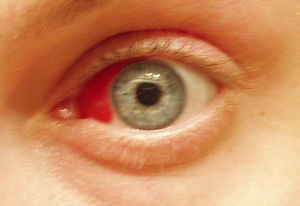We need you! Join our contributor community and become a WikEM editor through our open and transparent promotion process.
Subconjunctival hemorrhage
From WikEM
Contents
Background
- Bleeding of the conjunctival vessels into the subconjunctival space
- Can be spontaneous or related to trauma
- Spontaneous can be secondary to anticoagulation, bleeding diathesis, etc.
- If large and associated with trauma, need to maintain suspicion for occult Globe rupture (obscured by hemorrhage)[1]
- Bilateral and recurrent subconjunctival hemorrhage should have bleeding diathesis workup
Clinical Features
- Painless
- No effect on vision
- May recall a history of mild trauma or valsalva
- Examination
- Fresh red blood on a white sclera with clear borders[1]
- Masks the conjunctival vessels
Differential Diagnosis
Unilateral Red Eye
- Acute angle-closure glaucoma^
- Anterior uveitis
- Caustic keratoconjunctivitis^^
- Conjunctival laceration
- Conjunctivitis
- Corneal abrasion
- Corneal erosion
- Ocular foreign body
- Corneal ulcer^
- Endophthalmitis^
- Episcleritis
- Globe rupture^
- Herpes zoster ophthalmicus
- Intraocular foreign body
- Inflamed pingueculum
- Inflamed Pterygium
- Keratoconjunctivitis
- Keratoconus
- Lens dislocation
- Nontraumatic iritis
- Scleritis^
- Subconjunctival hemorrhage
- Traumatic hyphema
- Traumatic iritis
- Ultraviolet keratitis
^Emergent diagnoses
^^Critical diagnoses
Evaluation
- Clinical diagnosis
- Consider fluorescein staining to evaluate for corneal injury if suggested by history or if patient complains of pain[1]
Management
- Reassurance (will generally resolve within 10-14d)[1]

